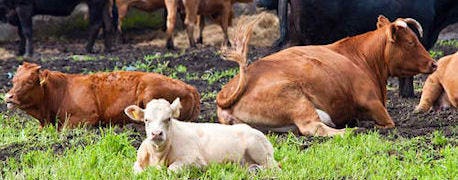May 7, 2014

High cattle prices this year aren't all that surprising, but the lofty heights of new price records certainly are, says Purdue University Extension economist Chris Hurt.
One record, posted by Nebraska steers, shows an average of $147 per live hundredweight – more than $20 higher than the previous first-quarter record price. In percentage terms, finished cattle prices in the first quarter this year were up 17% and production was down only 4%.

Purdue economist reviews factors affecting beef expansion, cattle price increases and consumer impacts
"It is easy to list some possible causes, but none of them seem to be large enough to have caused such startlingly high prices," Hurt said. "We start with the fact that meat and poultry supplies all were low. We have mentioned that the 4% reduced beef production and broiler egg hatchability has been low, reducing chicken supplies below expectations," Hurt explained.
The PED virus in hogs may have been the real kicker, primarily because the pork market seems to have sharply overshot prices due to the uncertainty of the actual death loss from the disease, Hurt said. There were also arguments that "maybe" demand was very strong, but first-quarter GDP growth of only 0.1% seems to discredit this argument. Data on trade are positive, but not enough to explain such high prices.
Related: Grain Prices To Stay Low, Cattle Prices High
"Much like pork, we are left with an incomplete understanding of why cattle prices were so high, especially in March and April," Hurt continued. "As in the pork sector, this may mean that cattle prices were 'caught up' in the fear of very short meat and poultry supplies and may have become overpriced."
Hurt said that this may be another example of the old market adage of "buy the rumor and sell the fact."
Record prices impact consumers, too
Record beef prices for consumers have also become a reality, Hurt said. In 2013, retail beef prices averaged $5.29 per pound but moved to a record $5.55 in the first quarter of 2014. Retail beef prices in 2014 are now expected to average $5.67 per pound, an increase of 7% over last year.
Related: Cattle Prices Cause Beef Price Increase At Grocery Store
"Current live-cattle futures markets are taking a more moderate approach to prices for the rest of the year now that the highs of the year are likely behind us," Hurt said. "Prices of finished cattle are expected to move downward to the mid-to lower $140s in May and June. Prices are expected to dip more in the third quarter with an average in the $135 to $139 range, and then recover into the low to mid-$140s for the last quarter average. Prices in 2013 averaged $126, and this year's new record is expected to be near $142," he said.
~~~PAGE_BREAK_HERE~~~
Imminent beef producer expansion?
Hurt said that unexplained high prices in the first four months of 2014 have added new excitement for cattle producers as they see strong profitability potential for the first time in years. This means that the conditions have become positive for some beef-cow producers to move toward expansion.
"The two conditions that we have suggested for expansion are the movement of calf prices above $1.75 per pound and restoration of pasture and grazing land after dry or drought conditions," Hurt said. "In terms of calf prices, calves weighing 500 to 550 pounds at Oklahoma City averaged $2.15 per pound in the first quarter and heifer calves averaged $1.93. Both were record highs."
According to Hurt, much of the country, but not all, has seen improved pasture conditions. The regions that remain a concern are the Southern Plains, the Southwest, and the West. The Drought Monitor from NOAA shows some anticipated drought abatement this summer for the Central Plains and Eastern Texas. If so, this means that only about 15% of the nation's brood cows will be in areas still in drought. Alternatively, about 85% of the beef cows are in regions where pasture and range is sufficient to promote herd expansion.
Related: No Increase In Beef Supply Likely Before 2016
"The evidence so far this year is that expansion has started as measured by reductions in female slaughter and by reduced numbers of heifers in the feedlots," Hurt said. "In the first quarter, the number of heifers slaughtered was down 7%, and the number of cows slaughtered was down 8%. In contrast, the steer slaughter was only down 3%. The reduced female slaughter alone accounted for 2% fewer animals in the total slaughter mix."
According to Hurt, the USDA's quarterly cattle-on-feed report suggested that fewer females have headed to the feedlots. On April 1, the number of heifers in feedlots was down 6% whereas steers were up 2%. "Some producers hold onto heifers to gain the flexibility to either move them to breeding herds or to later decide to sell them to feedlots," Hurt said. "Under current economic conditions, the odds favor many being added to the breeding herd.
"The expansion of the beef herd is just beginning and will likely extend for multiple years," Hurt concluded. "This means small supplies and strong prices of beef in 2015 and 2016. Beef producers, however, should expect both poultry and pork production to grow rapidly in 2015 and 2016."
Source: Purdue
You May Also Like




